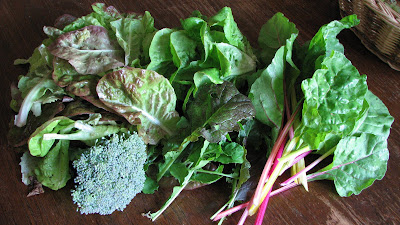Here's another harvest from earlier this week. We are definitely eating enough servings of greens these days!

I mentioned that we'll be getting greens like this for a month. I want to clarify that it won't be exactly like this for very long. We are noticing that the broccoli is already flowering and some of the lettuce is already beginning to bolt, but we will be able to harvest other lettuce (planted in shady spots in the garden), kale and chard for some time.

I am a little surprised that the broccoli didn't last longer. Both the broccoli and the lettuce that bolted were bought as seedlings from Lowe's so I'm not sure what varieties they are. Most of the lettuces that we ordered from Cook's Garden and started from seed are still growing and doing fine.
I took some more pictures of the garden for this week. These next two pictures were taken from the same spot. The one below is mostly cold season stuff -- lettuce, chard, kale, cabbage, brussel sprouts. We took up the broccoli salad greens that we had in the back left corner. They were attacked by flea beetles and never really formed any kind of broccoli-like head. Then, we put down some collard seedlings we started a while ago. Then, they were attacked by what we think were the flea beetle larvae. We found little black wormy caterpillar looking things eating the collards leaves. We tried to save them with diatomaceous earth but I think it was too late. There are a few collards left in that spot, and we put some hot peppers in with them. The peppers haven't been bothered by the beetles yet.

The next photo is of the middle three rows which are the classic summer veggies. The cukes, eggplants, tomatoes, squash, basil, and cantelope were started from seed indoors. The bush beans and okra we direct seeded after the frost date. Things are looking pretty nice so far. To the right of this picture are the onions, potatoes, garlic, lettuce and peas.

Here's a picture of the damage done by the flea beetles. These are baby eggplants that we started indoors. They are about 4-6 inches tall now. We also bought some bigger eggplant last weekend just in case we lose these guys.

We are using
diatomaceous earth to control the flea beetles and it works really well. This organic treatment was recommended to us by our friends at
Five Leaves Farm (the local CSA). It is a white powder that you can sprinkle on and around plants to keep any kind of small creatures/pests away. I've heard it being used for slugs, beetles, fleas, and even roaches around the home. It is made of the skeletal remains of tiny unicellular plants that are very sharp to a tiny pest. This is the first year that I've seen it at Lowe's hardware and you can also find it at a local nursery or seed and feed.
Below is our newly planted bed of peppers. Since we were only able to get a few peppers to grow from seed indoors we bought 4 different kids of pepper plants last weekend. We planted them here in this bed where we had winter greens. There are pole beans and snow peas growing up a trellis on the porch behind them.

Lastly, this is a bed of butternut squash and pole beans. I've also planted some seminole pumpkin seeds in the middle. We've never grown these pumpkins but a friend suggested them after having success with them last year. These pumpkins and the butternut squash are supposed to be less susceptible to the vine borer bug. We are hoping to win the battle against squash vine borers in this bed this year!

Originally posted May 5, 2009







































